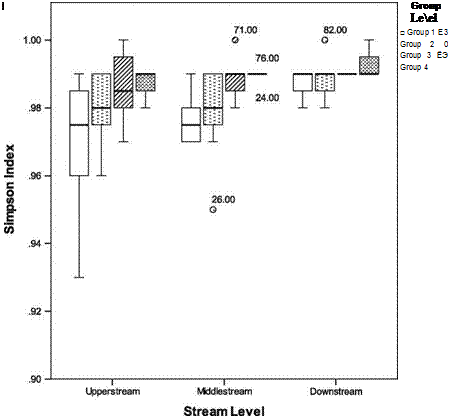A higher heterogeneity was predominantly found in the pekarangan system because of a large number of ornamental plants, meaning pekarangan can be more adaptable to human disturbance (Fig. 17.7). Plants are mostly ornamental in utilization (47.2 %) and predominantly 0-1 m in height (51.2 %). In addition, plants with height more than 2 m were up to 19.9 % of the total, which means pekarangan can support plant growth without any limitations.
The relationship between the Margalef index and the stream level shows that the middle stream has a higher index value compared to other stream levels (Fig. 17.8): this is determined to be the effect of the ecotone condition, which changed plant heterogeneity in the middle stream. Furthermore, G3 and G4 have higher index value compared to G1 and G2, but these differences are not significant for those groups at the upper stream. These conditions were caused by the different size of open area and the topography level. The middle and downstream have flat areas, which encouraged the household to plant many kinds of species.
The relationship between the Simpson index and stream level shows that the upper stream is more varied compared to other stream areas (Fig. 17.9). In addition, all respondents represent a high index value, close to 1. Thus, the uniformity of individual quantities of various species inside pekarangan increases by group levels
 |
but is almost same between the stream levels. It is also proof that the more species, the higher the chance that the same species can be found.
The relationship between the Shannon-Wiener index and stream level shows that the index values range from 2.5 to 3.5, which means species diversity is high inside the pekarangan area (Fig. 17.10). A trend is shown that G1 and G3 have lower values compared to G2 and G4, because the ownership of OAL caused the household to also plant some crops in pekarangan. The Sorenson index shows that the similarity of plants among pekarangan is high (Fig. 17.11).
Two groups (G1 and G2) were combined to represent a small pekarangan group, while G3 and G4 formed a large pekarangan group. In addition, G1 and G3 were also combined into non-OAL groups, while G2 and G4 were crafted into OAL groups. There are no significant differences in either pekarangan size or OAL within the orientation and stream levels. However, the physical conditions of pekarangan, that
 |
is, pekarangan size, building size, open area size, OAL size, number of species, and number of households, were significantly different. It was found that G1 has the lowest biodiversity, followed by G2, then G3, and finally G4 has the highest.



